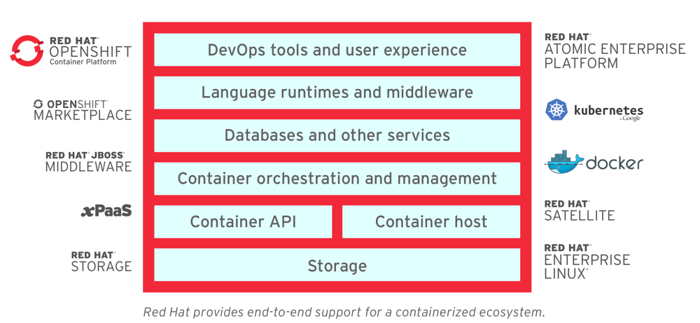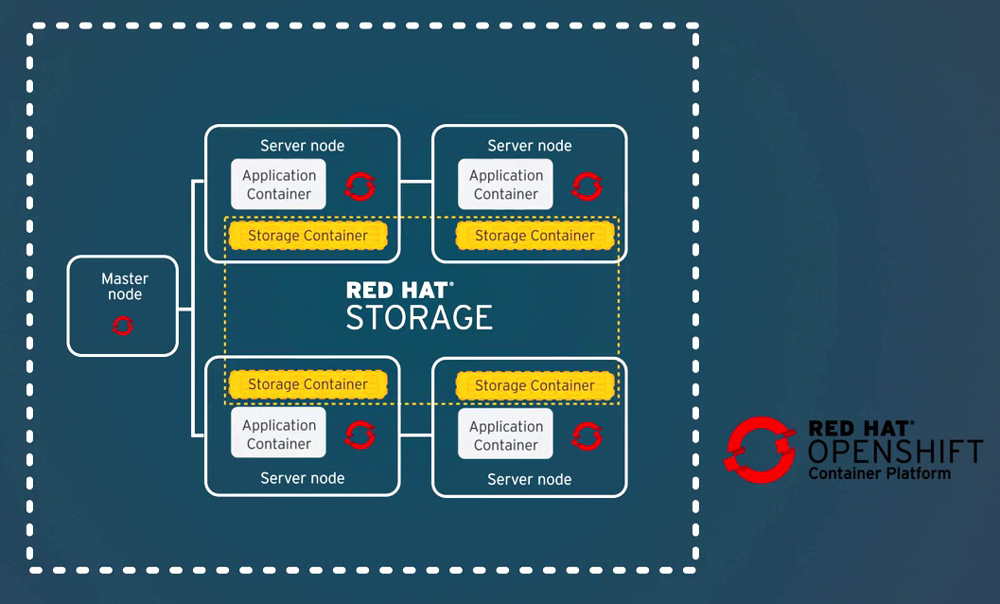Container-Native Storage 3.6 From Red Hat
With support for containerized applications and infrastructure in OpenShift Container Platform clusters
This is a Press Release edited by StorageNewsletter.com on October 13, 2017 at 3:15 pmRed Hat, Inc. announced Container-Native Storage 3.6, with support for containerized applications and infrastructure in OpenShift Container Platform clusters.
Persistent storage for containers
Container-Native Storage 3.6 comes on the heels of OpenShift Container Platform 3.6, the latest version of the company’s enterprise-grade Kubernetes container application platform, announced in August.
Container-Native Storage, built upon Gluster Storage, is integrated with OpenShift Container Platform and uniquely serves storage out of containers. Gluster Storage is enterprise-grade, durable, more secure and suited for the hybrid cloud as it supports both on-premise or public cloud deployments. These attributes make it suited to OpenShift Container Platform deployments. Container-Native Storage can eliminate the need to have an independent storage platform, enabling customers to achieve one integrated container platform that can span the hybrid cloud with efficiency and cost savings, a streamlined user experience, single control plane and a single point of support.
Container-Native Storage 3.6
The move to container-based applications can bring challenges to existing traditional storage architectures, holding back the drive for innovation and progress. Software-defined container-native storage addresses the challenges with the ability to merge the storage services with the container platform like any other container service and runs on physical, virtual, public cloud and on top of traditional storage appliances. Existing traditional storage architectures do not always offer this level of inherent scale and flexibility and, as a result, can fall short of unlocking the potential of container application platforms like Red Hat OpenShift Container Platform.
With Container-Native Storage 3.6, the company is provider of native storage
for container platforms with following features:
-
Versatile storage platform for containers enabling customers to manage, scale, and upgrade their storage needs using a single control plane helping customers to achieve storage efficiency and cost savings. Container-Native Storage offers support for file, block, and object interfaces, enabling container applications portability to the container platform without change. The addition of block storage (via iSCSI) provides support for distributed databases and other low-latency workloads like Elasticsearch, while the addition of object storage (under technology preview) provides an embedded object store within OpenShift Container Platform for cloud-native applications needing Amazon Simple Storage Service (Amazon S3) like protocol support.
-
Support for all core infrastructure elements of OpenShift Container Platform, including its registry, logging, and metrics. Support for these core components enables storage administrators to have Container-Native Storage for infrastructure out-of-the-box, without needing to use disparate storage systems for different infrastructure aspects and have one integrated platform with simplified management, procurement, and support.
-
Three-fold increase in the number of applications and microservices deployed on a single storage cluster. Increased persistent volume density offers customers greater resource utilization.
Test Drive OpenShift Container Platform with Container-Native Storage
The company is also rolling out a OpenShift Container Platform with Container-Native Storage Test Drive (registration required), enabling customers to simulate OpenShift deployments via the public cloud. This Test Drive aims to provide an inquiring administrator with a full multi-node OpenShift Container Platform cluster, running in the cloud. Customers will be able to explore lab exercises designed to expose them to different administrative and operational tasks with both the firm’s OpenShift and Container-Native Storage.
Ranga Rangachari, VP and GM, storage, Red Hat, said: “As enterprises deploy containers, many see a need for storage solutions designed specifically for these types of systems. Red Hat Container-Native Storage, optimized for multi/hybrid cloud deployments with Red Hat OpenShift Container Platform, offers that. The addition of support for a broad range of storage workloads, the support for the Red Hat OpenShift Container Platform’s core infrastructure pieces, and increased persistent volume density are key features to help customers support present and future datacenters, and all further strengthen the tight integration of Red Hat Container-Native Storage with Red Hat OpenShift Container Platform.“
Henry Baltazar, VP, research, 451 Research, said: “As enterprises move over to hybrid cloud infrastructures and support on premise and public cloud deployments, they need to ensure support for containerized applications and infrastructure with a secure, integrated storage platform. Next-generation workloads like microservices and containers are going to demand more agility and scalability from storage systems, which will have a direct impact on TCO. Red Hat Container-Native Storage enables customers to move to a single integrated container platform across their hybrid cloud infrastructure, creating a versatile storage platform for containers while simplifying management.“
Container-Native Storage 3.6 is expected to be available later this month.
















 Subscribe to our free daily newsletter
Subscribe to our free daily newsletter

